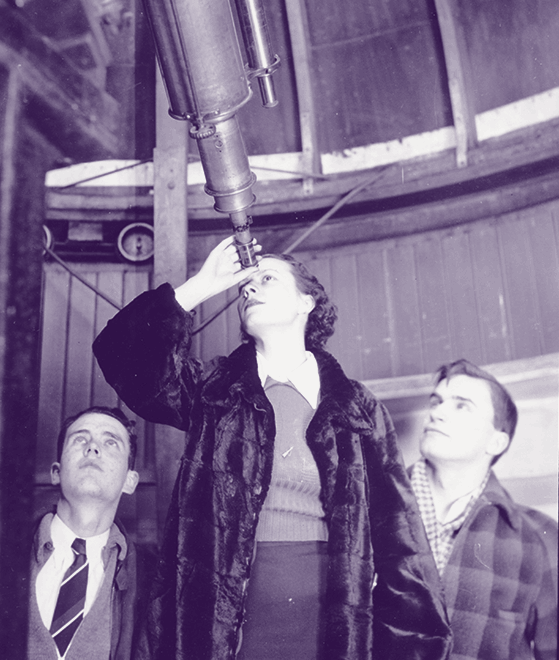
Knox Professor, Students Teach Others About Alaska Salmon
Outreach program in Sitka focuses on fish as valuable natural resource

One of the most memorable events of Elizabeth Cockrell's summer occurred when the Knox College environmental studies major attended a two-hour meeting -- in the middle of an Alaskan stream -- to talk about fish.
"We stood there, and the little coho salmon were swimming around our feet," recalled Cockrell (shown above, in red shirt, helping to position a log for salmon habitat).
Cockrell, 2011 Knox graduate Helen Schnoes, and Knox faculty member Nic Mink spent three months in Sitka, Alaska, where they collaborated with community members to develop a program to educate people about salmon as a valuable natural resource.
That program became Sitka Salmon Tours, a Sitka Conservation Society initiative that focuses on salmon education, outreach, and research.
A visiting assistant professor of environmental studies at Knox, Mink is the Sitka Conservation Society's salmon education and outreach coordinator in the summer. He also served as director of the tour operation, leading walking tours that tell visitors -- many of them tourists on cruise ships -- about the salmon's life cycle and how important it is to preserve salmon habitat. The walking tour takes visitors to such locales as Indian River, a fish hatchery in a local science center, and a salmon-processing plant.
"We have this asset here. It's salmon," he said. "By telling its story, we're helping to protect it as a resource."
A primary goal is to raise public awareness about southeast Alaska's wild, sustainable salmon fishery and to help people understand the connection that exists between salmon and the Tongass National Forest, the nation's largest national forest and one of the world's last great remaining terrestrial habitats for wild salmon.
"Salmon need well-shaded streams to keep the waters cool enough for them to survive and thrive," Mink said, adding that clear-cut logging during the 1960s, 1970s, and 1980s destroyed some salmon habitat that now is being restored. (Photo above right: Mink leads a walking tour.)
Helen Schnoes: Doing 'whatever needed to be done'
 As the Sitka Salmon Tours "sustainable salmon intern," Schnoes helped build the program, devoting much of her time to marketing, promotions, political advocacy, and "whatever needed to be done," she said.
As the Sitka Salmon Tours "sustainable salmon intern," Schnoes helped build the program, devoting much of her time to marketing, promotions, political advocacy, and "whatever needed to be done," she said.
Originally from Minneapolis, Minnesota, Schnoes majored in creative writing and political science at Knox College, where she became involved with the Community Garden and honed an interest in food and sustainability issues. She quickly jumped at the chance to spend a summer working in Alaska.
"Why wouldn't I?" she asked. "It aligned with my interests in environment, politics, food, sustainability. Opportunity was knocking on my door. Why wouldn't I open the door and see where it goes?"
"This is what really interests me about what we're doing with the salmon tours: Talking about salmon as a food and how we need to have policies in place that keep it going," she said. "It's expanded how I think about the food system." (Photo above left: Schnoes, third from right in the back row, with a stream restoration team.)
Elizabeth Cockrell: Doing the 'nitty-gritty' work of habitat restoration
 Cockrell, a senior from Jacksonville, Illinois, worked as the U.S. Forest Service salmon intern. In effect, Mink said, she was "our eyes and ears on the ground."
Cockrell, a senior from Jacksonville, Illinois, worked as the U.S. Forest Service salmon intern. In effect, Mink said, she was "our eyes and ears on the ground."
She took videos and photographs, and she conducted interviews with Forest Service employees and area residents, asking about their views on salmon.
"I've definitely learned that salmon are not just something of economic value to the southeast part of Alaska," said Cockrell, who previously gained interviewing experience during a sociology class taught by Gabrielle Raley, Knox assistant professor of anthropology-sociology.
People in southeast Alaska feel a deep personal connection to salmon, Cockrell said. "It's been enlightening to me because I had no idea it was such a big thing."
She also spent a lot of time outdoors with Forest Service personnel, helping them with the "nitty-gritty work" of habitat restoration, such as positioning logs in a stream. (Photo above left: Cockrell helps set up a winch, which will drag another log into the stream. Photo at right: Elizabeth Cockrell, Nic Mink, and Helen Schnoes at Crescent Bay in Alaska.)
"I find it really fascinating. I love experiencing the outdoors," Cockrell said. "Doing the nitty-gritty work is really fun because it's so rewarding to know that not only have I documented the restoration work that's being done, but I also helped build that salmon habitat."
Published on September 02, 2011

